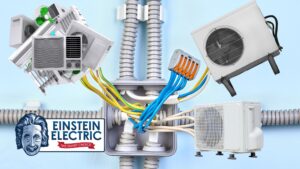Smart home technology is becoming increasingly popular, and it’s no surprise why. With the ability to control your home’s electrical system remotely, automate routine tasks, and enhance security, smart home technology offers many benefits. However, like any technology, it also has its drawbacks. In this blog, we’ll explore the pros and cons of smart home technology for your electrical system.
Pros:
Convenience and Ease of Use
The convenience and ease of use provided by smart home technology revolutionize the way we interact with our homes. With just a few taps on a smartphone or a voice command to a virtual assistant, we can effortlessly manage various aspects of our living spaces. Whether it’s dimming the lights, setting the temperature, or even starting the coffee machine, smart home devices offer unparalleled convenience.
Gone are the days of fumbling for switches or manually adjusting thermostats. With smart home technology, everything is at our fingertips. The intuitive interfaces and user-friendly apps make it effortless for anyone to navigate and control their smart devices, regardless of technical expertise.
The ability to remotely access and control our homes adds another layer of convenience. Whether we’re at work, on vacation, or simply in another room, we can effortlessly monitor and adjust our home’s settings. This level of control not only enhances convenience but also promotes energy efficiency and security.
Overall, the convenience and ease of use offered by smart home technology bring a new level of comfort and efficiency to our daily lives, making our homes more responsive and adaptable to our needs.
Energy Savings
Energy savings is a significant advantage of integrating smart home technology into our living spaces. With the ability to automate and optimize energy consumption, smart devices play a crucial role in reducing energy waste and promoting sustainability.
By automatically turning off lights when a room is unoccupied or adjusting the thermostat based on occupancy patterns and weather conditions, smart homes ensure that energy is utilized efficiently. Additionally, smart plugs and power strips can be programmed to cut off power to electronics and appliances when they are not in use, preventing standby power consumption.
Furthermore, smart home systems often provide real-time energy monitoring, allowing homeowners to track their energy usage and identify areas where improvements can be made. With this information, individuals can make informed decisions about their energy consumption habits and adjust accordingly.
Not only do these energy-saving practices lead to reduced energy bills, but they also contribute to a greener environment by lowering carbon emissions associated with energy production. Smart home technology empowers individuals to make more sustainable choices and actively participate in the conservation of our planet’s resources.
Smart home technology enables us to achieve significant energy savings by automating tasks, optimizing energy consumption, and providing valuable insights into our energy usage. By embracing these technologies, we can make a positive impact on both our wallets and the environment.
Improved Security
Improved security is a paramount benefit of incorporating smart home technology into our living spaces. By integrating advanced security features, smart homes provide enhanced protection and peace of mind for homeowners.
Smart locks offer a high level of convenience and security. With the ability to lock and unlock doors remotely using a smartphone or key fob, homeowners can control access to their homes from anywhere. This feature proves invaluable when family members or trusted individuals need access to the house in our absence. Additionally, smart locks often have built-in features like keyless entry codes or fingerprint recognition, further reducing the risk of unauthorized entry.
Furthermore, smart home security systems include surveillance cameras that can be monitored remotely. By accessing live video feeds from security cameras through a smartphone or other devices, homeowners can keep an eye on their property at all times. Motion sensors integrated with the security system can trigger alerts and notifications, allowing homeowners to respond promptly to any suspicious activity.
Moreover, smart home technology enables the integration of additional security measures such as door/window sensors, glass break detectors, and even smart lighting systems that can be programmed to simulate occupancy when the house is empty.
The ability to receive real-time notifications when someone enters or exits the home adds another layer of security. Whether it’s a family member, a guest, or an intruder, these alerts allow homeowners to stay informed and take appropriate action if necessary.
Smart home technology offers improved security through features like remote locking, surveillance cameras, motion sensors, and notifications. By providing homeowners with greater control and visibility over their homes, smart homes contribute to a safer living environment and provide peace of mind, whether we are present or away.
Increased Accessibility
Smart home technology has made significant strides in increasing accessibility for individuals with disabilities or mobility challenges. By leveraging voice-activated assistants, assistive technologies, and intuitive interfaces, smart homes empower individuals to control their living environments without physical interaction with switches or appliances.
Voice-activated assistants, such as Amazon Alexa or Google Assistant, serve as intelligent companions that can understand and respond to voice commands. By integrating these assistants with smart home devices, individuals can effortlessly control various functions within their homes. From adjusting the lights and temperature to controlling appliances and opening doors, voice commands provide an accessible and convenient way to interact with the environment.
Smart home technology also enables the integration of assistive devices, such as home automation systems that can be controlled via specialized interfaces or apps tailored for individuals with disabilities. These interfaces often offer customizable options, including larger fonts, high contrast settings, or voice guidance, catering to specific accessibility needs.
Furthermore, smart homes can incorporate features like motion sensors and automatic lighting systems that respond to movement. This eliminates the need for manual switches and provides a seamless and accessible experience for individuals with limited mobility.
By simplifying daily tasks and reducing physical exertion, smart home technology promotes independence and autonomy for individuals with disabilities. It enables them to have greater control over their living spaces, enhancing their overall quality of life.
Smart home technology has paved the way for increased accessibility by providing voice-activated control, assistive technologies, and intuitive interfaces. By eliminating physical barriers and simplifying interaction with the home environment, smart homes empower individuals with disabilities to live more independently and comfortably.
Cons:
Initial Cost
While the benefits of smart home technology are undeniable, one significant drawback is the initial cost involved. Smart home devices can be expensive, and the overall expense can quickly add up, especially if you aim to automate multiple aspects of your home.
To fully automate your home’s electrical system, you may need to invest in various devices such as smart thermostats, smart plugs, smart lighting systems, security cameras, and more. Additionally, you may require a central hub or controller to connect and manage these devices effectively. The cost of purchasing and installing these devices can be a significant upfront investment.
However, it is important to consider the potential long-term savings and benefits that smart home technology can provide. Energy-saving features can help reduce utility bills over time, while enhanced security measures can offer peace of mind and potential savings on insurance premiums. These factors can help offset the initial cost and provide value over the life span of the smart home system.
Furthermore, it’s worth noting that as smart home technology continues to advance and gain popularity, prices are gradually decreasing, making it more accessible for a wider range of homeowners. Additionally, there are often different price options and levels of complexity available, allowing homeowners to choose a system that aligns with their budget and needs.
The initial cost of implementing smart home technology can be a deterrent for some homeowners. However, it is crucial to weigh this expense against the long-term benefits and potential savings that smart homes offer. As the technology becomes more prevalent and affordable, it is expected that the initial cost barrier will continue to decrease over time.
Compatibility Issues
Compatibility issues can pose a significant challenge when it comes to smart home technology. With numerous brands, devices, and protocols available in the market, ensuring seamless integration and compatibility can be a complex task.
Different smart home devices often operate on different communication protocols, such as Zigbee, Z-Wave, or Wi-Fi. This means that devices from one brand may not communicate or work seamlessly with devices from another brand. As a result, homeowners may find themselves needing to use multiple apps or control systems to manage their smart home devices, leading to a fragmented user experience.
Moreover, firmware updates or software changes can occasionally introduce compatibility issues. A device that worked perfectly before an update may suddenly become incompatible with other devices in the system, requiring troubleshooting or even replacing the device to restore functionality.
The complexity of compatibility issues can be further exacerbated when integrating third-party devices or expanding an existing smart home system. It may require technical expertise to identify and resolve compatibility conflicts, making it challenging for the average homeowner to troubleshoot these issues independently.
To mitigate compatibility challenges, it is essential to research and choose devices that are known to be compatible with each other or opt for smart home ecosystems offered by a single brand. These ecosystems often provide a more streamlined and cohesive experience, ensuring compatibility and ease of use.
Compatibility issues can arise when integrating smart home devices from different brands or utilizing various protocols. These issues can result in the need for multiple apps or systems, leading to confusion and frustration. To minimize compatibility challenges, thorough research and selecting devices from a single brand or ecosystem can help ensure a more seamless smart home experience.
Privacy Concerns
Privacy concerns are a significant consideration when it comes to smart home technology. As these devices collect and store data on users’ habits, preferences, and usage patterns, there is a potential risk that this information could be accessed or exploited by third parties.
Smart home devices often rely on cloud services to store and process data, which introduces a level of vulnerability. The data transmitted from these devices, such as voice recordings or video footage, can be susceptible to interception or unauthorized access if not adequately protected.
Furthermore, there is a potential for data breaches or hacking attempts targeting smart home systems. If a malicious actor gains access to your smart home network, they could potentially gather sensitive information or even gain control over the connected devices.
To address privacy concerns, it is crucial to carefully review the privacy policies and terms of service of the smart home devices and services you use. Understand how your data is collected, stored, and shared, and ensure that you are comfortable with the level of control you have over your personal information.
Taking steps to secure your smart home network is essential. This includes using strong, unique passwords for all connected devices, regularly updating firmware and software to patch vulnerabilities, and implementing additional security measures such as two-factor authentication or virtual private networks (VPNs).
Consider using devices and services from reputable manufacturers with a strong track record in privacy and security. Look for features that prioritize user privacy, such as local storage options for data, encryption protocols, and privacy-focused settings.
While smart home technology offers convenience and automation, it also brings privacy concerns. Understanding the privacy implications, reading privacy policies, and taking proactive steps to secure your data and network are crucial to mitigate potential risks and protect your privacy in a smart home environment.
Reliability
Reliability is a key consideration when it comes to smart home technology. While these systems offer convenience and automation, they can be subject to occasional disruptions and technical issues that affect their reliability.
One common factor that can impact reliability is internet connectivity. Most smart home devices rely on an internet connection to communicate and function properly. In the event of an internet outage or unstable network, the functionality of these devices can be compromised. This means that you may not be able to control your home’s electrical system remotely or receive notifications from your smart home devices.
Device malfunctions or firmware bugs can also contribute to reliability issues. Software updates or compatibility conflicts may cause unexpected behavior or even temporary failures in the system. In such cases, manual intervention or troubleshooting may be required to restore the desired functionality.
Power outages can also impact the reliability of smart home technology. If there is a power outage, devices may lose power or fail to function until the power is restored. While some devices have backup power options, not all devices have this capability.
To mitigate reliability concerns, it’s important to choose smart home devices from reputable manufacturers known for their reliability and quality. Additionally, staying up to date with firmware updates and regularly checking the performance of your smart home system can help identify and address potential issues before they become more significant problems.
While smart home technology has come a long way in terms of reliability, it’s essential to understand that occasional disruptions or technical issues can occur. Being prepared for such situations and having alternative means to control your home’s electrical system can help ensure a smoother experience even in the face of unexpected challenges.
Overall, the pros and cons of smart home technology for your electrical system will depend on your individual needs and preferences. While the convenience, energy savings, improved security, and accessibility benefits are compelling, the initial cost, compatibility issues, privacy concerns, and reliability issues may be significant drawbacks for some homeowners. If you’re considering investing in smart home technology, it’s important to do your research, evaluate your needs and budget, and choose devices that are compatible with each other and with your lifestyle.





















